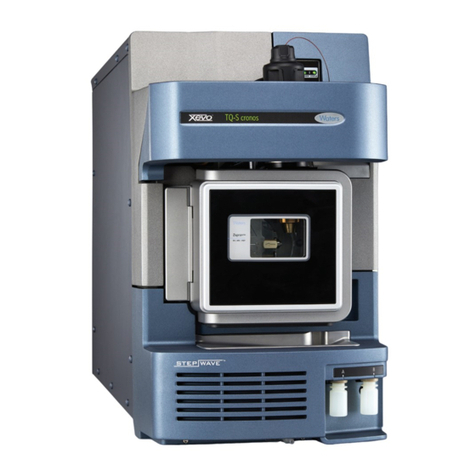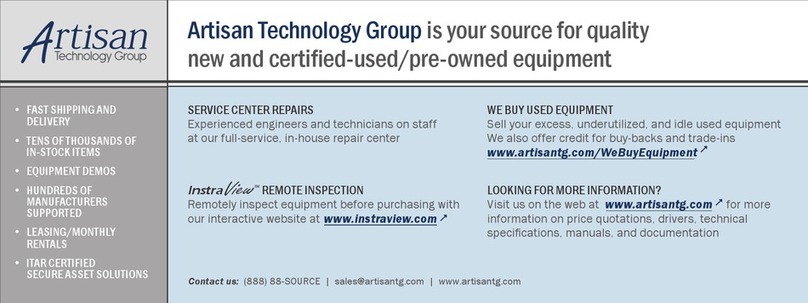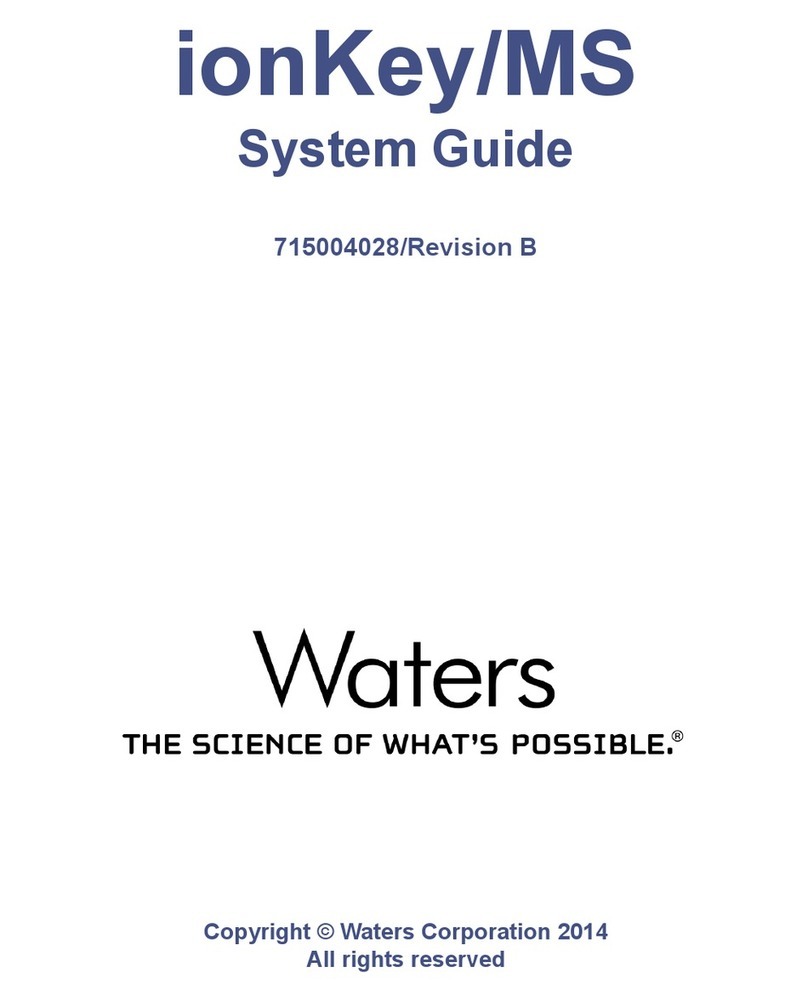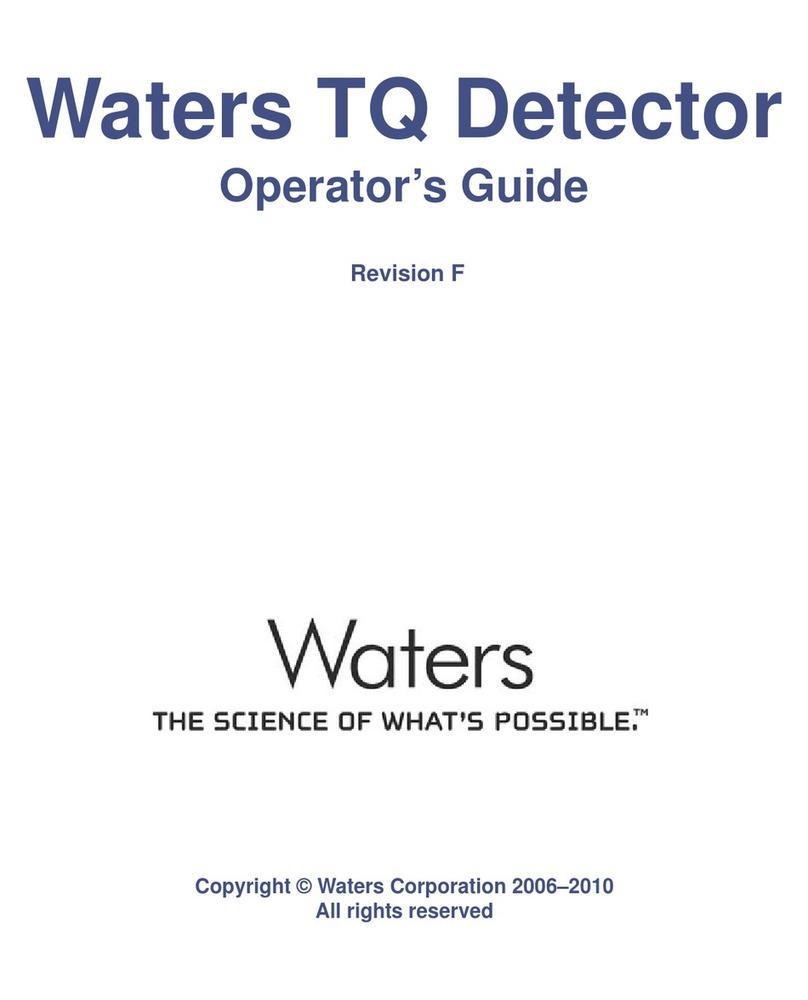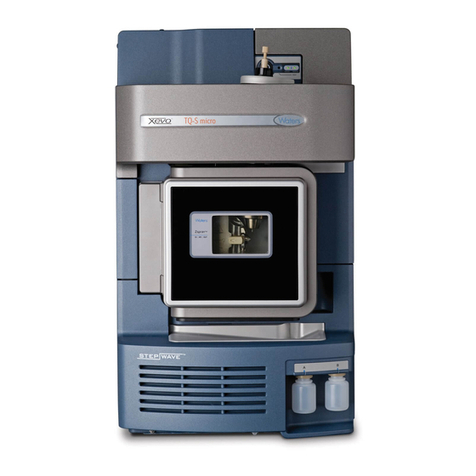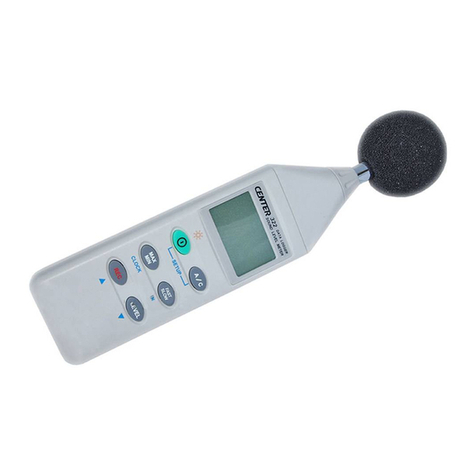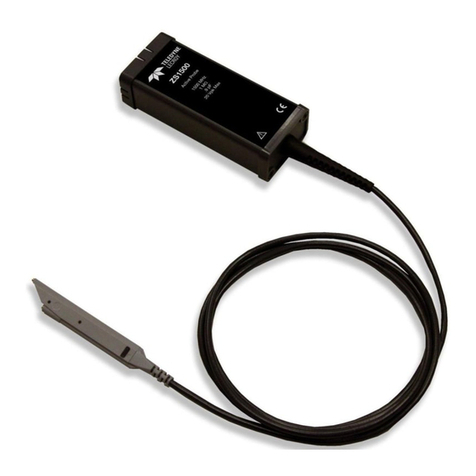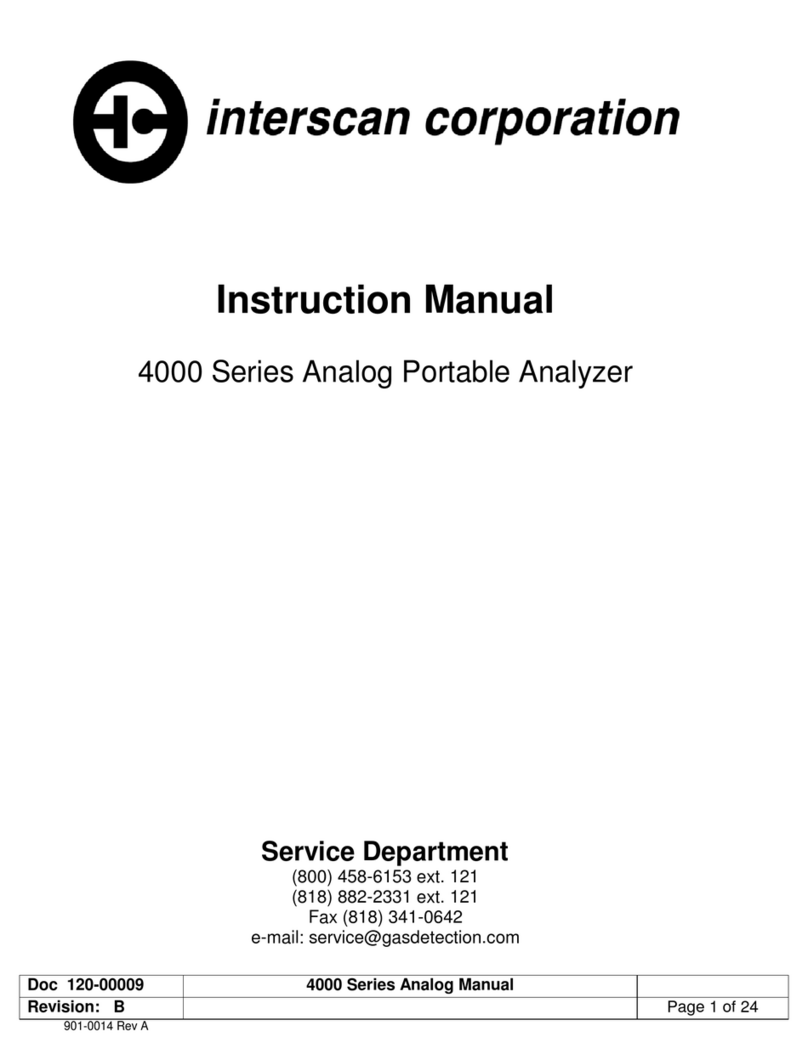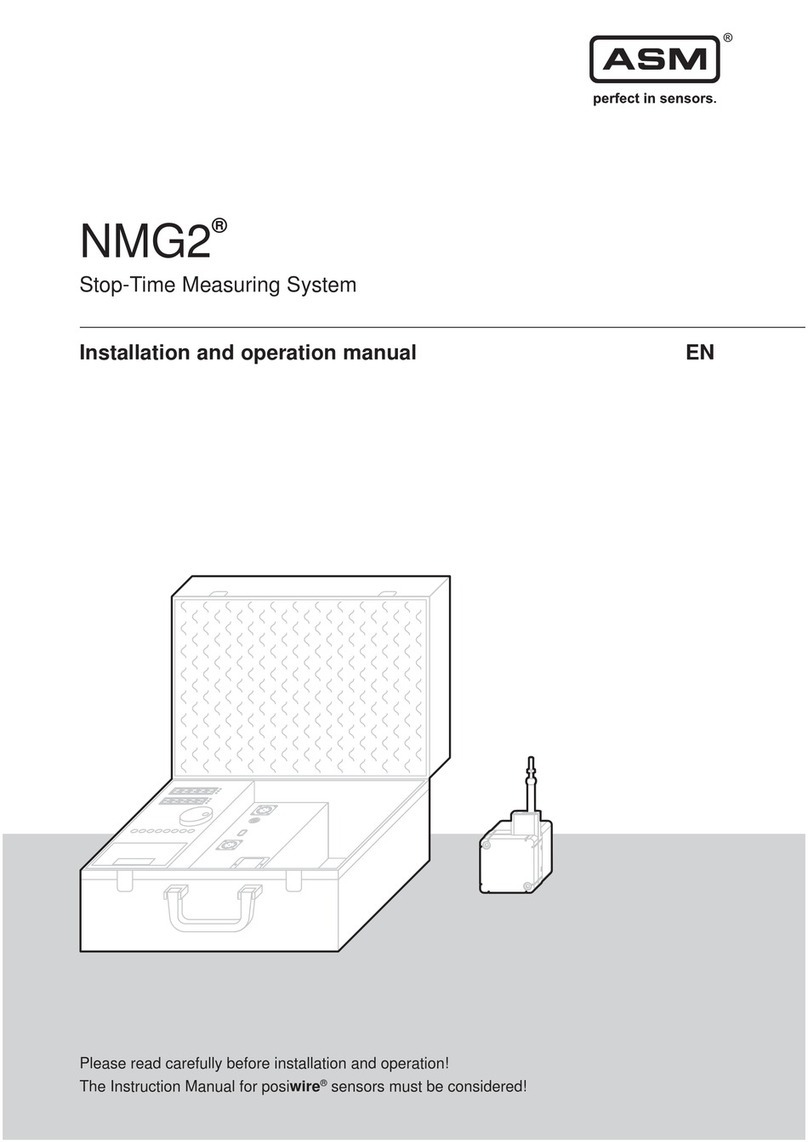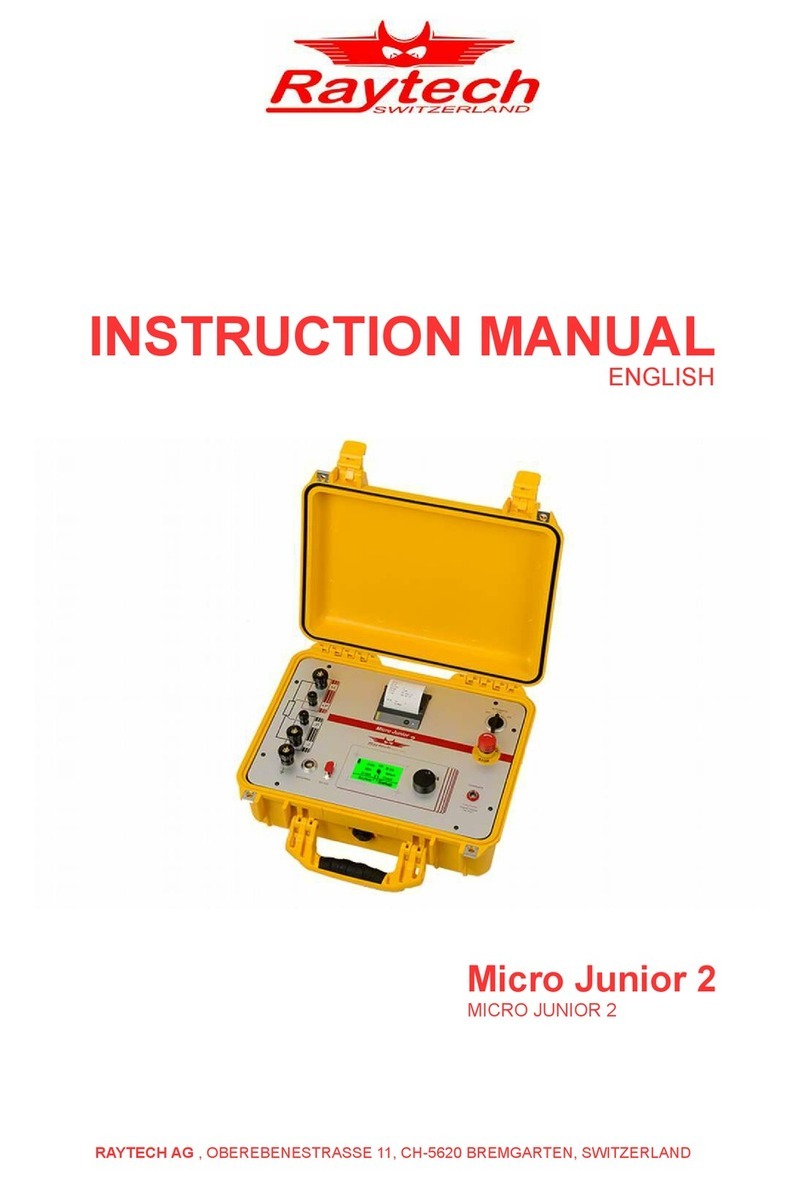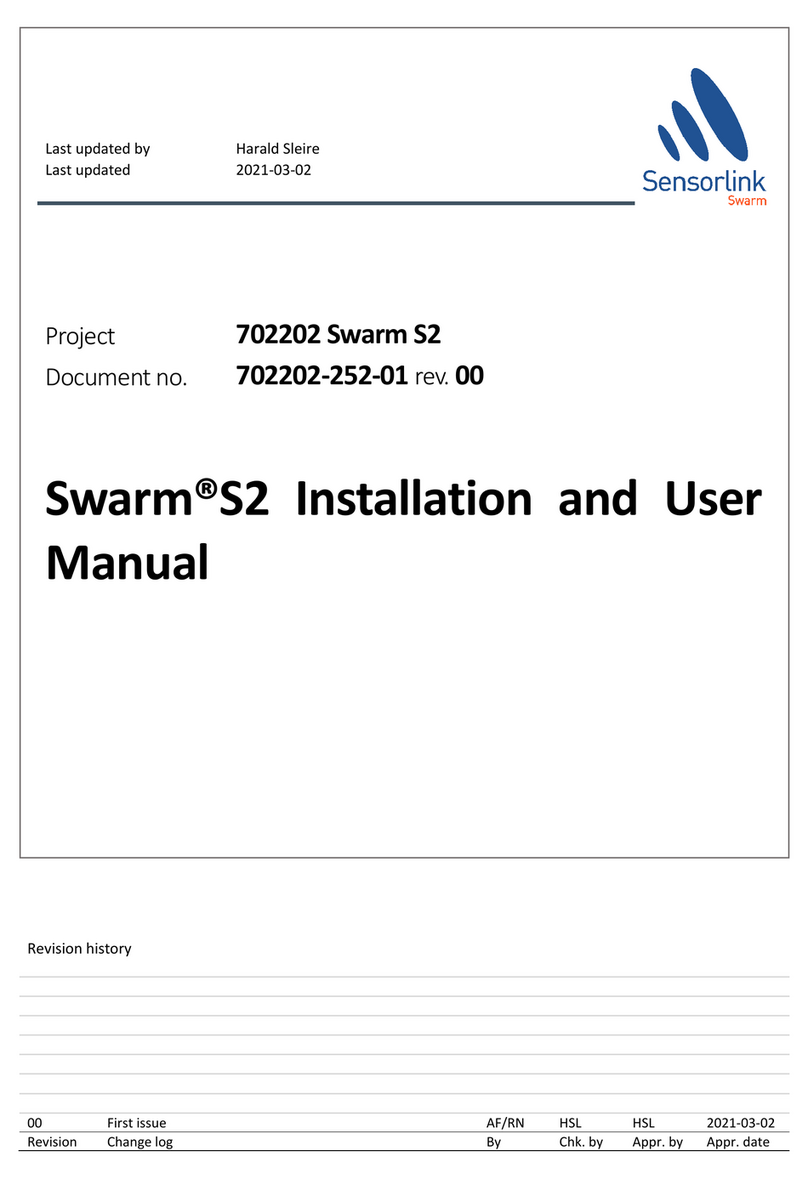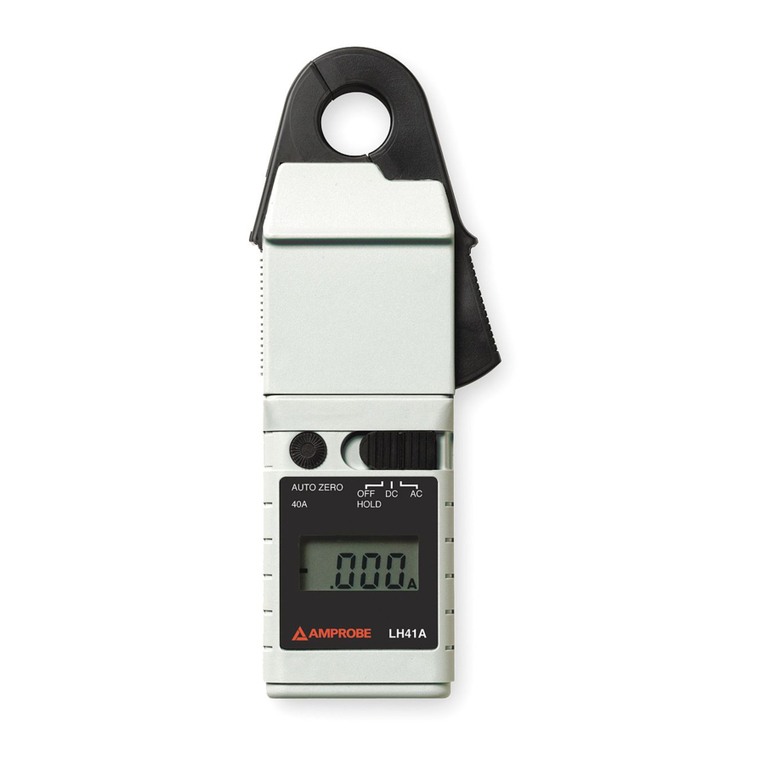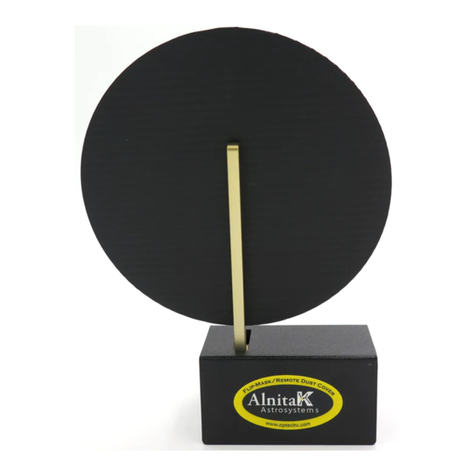Waters Xevo TQ-XS Mass Operating manual

Waters Xevo TQ-XS Mass
Spectrometry System
Overview and Maintenance Guide
715004990
Revision A
Copyright © Waters Corporation 2016
All rights reserved

General information
Copyright notice
© 2016 WATERS CORPORATION. PRINTED IN THE UNITED STATES OF AMERICA AND IN
IRELAND. ALL RIGHTS RESERVED. THIS DOCUMENT OR PARTS THEREOF MAY NOT BE
REPRODUCED IN ANY FORM WITHOUT THE WRITTEN PERMISSION OF THE PUBLISHER.
The information in this document is subject to change without notice and should not be construed
as a commitment by Waters Corporation. Waters Corporation assumes no responsibility for any
errors that may appear in this document. This document is believed to be complete and accurate
at the time of publication. In no event shall Waters Corporation be liable for incidental or
consequential damages in connection with, or arising from, its use. For the most recent revision
of this document, consult the Waters Web site (waters.com).
Trademarks
ACQUITY® is a registered trademark of Waters Corporation.
ACQUITY UPLC® is a registered trademark of Waters Corporation.
Alliance® is a registered trademark of Waters Corporation.
Connections INSIGHT® is a registered trademark of Waters Corporation.
DART® is a registered trademark of ionSense Inc.
ESCi® is a registered trademark of Waters Corporation.
EdwardsTM is a trademark of Edwards Limited.
GELoader® is a registered trademark of Eppendorf-Netheler-Hinz GmbH.
iKeyTM is a trademark of Waters Corporation.
ionKeyTM is a trademark of Waters Corporation.
IntelliStartTM is a trademark of Waters Corporation.
LDTDTM is a trademark of Phytronix Technologies Inc.
Leybold® is a registered trademark of Oerlikon Leybold Vacuum GmbH.
LockSprayTM is a trademark of Waters Corporation.
MassLynx® is a registered trademark of Waters Corporation.
June 9, 2016, 715004990 Rev. A
Page ii

Nano LCTM is a trademark of Waters Corporation.
nanoACQUITY® is a registered trademark of Waters Corporation.
NanoFlowTM is a trademark of Waters Corporation.
nanoTile® is a registered trademark of Waters Corporation.
Oerlikon® is a registered trademark of OC Oerlikon Corporation AG.
OpenLynxTM is a trademark of Waters Corporation.
PEEKTM is a trademark of Victrex PLC.
PEEKsilTM is a trademark of SGE Analytical Science Pty Ltd.
RADARTM is a trademark of Waters Corporation.
ScanWaveTM is a trademark of Waters Corporation.
StepWaveTM is a trademark of Waters Corporation.
Swagelok® is a registered trademark of Swagelok Company.
SymbiosisTM is a trademark of Spark Holland Inc.
T-WaveTM is a trademark of Waters Corporation.
THE SCIENCE OF WHAT'S POSSIBLE® is a registered trademark of Waters Corporation.
TRIZAIC® is a registered trademark of Waters Corporation.
TargetLynxTM is a trademark of Waters Corporation.
UNIFI® is a registered trademark of Waters Corporation.
UniSprayTM is a trademark of Waters Corporation.
UPLC® is a registered trademark of Waters Corporation.
UltraPerformance LC® is a registered trademark of Waters Corporation.
Viton® is a registered trademark of DuPont Performance Elastomers LLC.
Waters® is a registered trademark of Waters Corporation.
Xevo® is a registered trademark of Waters Corporation.
ZSprayTM is a trademark of Waters Corporation.
All other trademarks or registered trademarks are the sole property of their respective owners.
Customer comments
Waters’ Technical Communications organization invites you to report any errors that you
encounter in this document or to suggest ideas for otherwise improving it. Help us better
June 9, 2016, 715004990 Rev. A
Page iii

understand what you expect from our documentation so that we can continuously improve its
accuracy and usability.
We seriously consider every customer comment we receive. You can reach us at
Contacting Waters
Contact Waters with enhancement requests or technical questions regarding the use,
transportation, removal, or disposal of any Waters product. You can reach us via the Internet,
telephone, or conventional mail.
Waters contact information
Contacting medium Information
Internet The Waters Web site includes contact information for Waters locations
worldwide.
Visit www.waters.com
Telephone and fax From the USA or Canada, phone 800-252-4752, or fax 508-872-1990.
For other locations worldwide, phone and fax numbers appear in the
Waters Web site.
Conventional mail Waters Corporation
Global Support Services
34 Maple Street
Milford, MA 01757
USA
System manufacturing information
Manufacturer:
Waters Corporation
34 Maple Street
Milford, MA 01757
USA
Manufacturing site:
Waters Technologies Ireland Ltd.
Wexford Business Park
June 9, 2016, 715004990 Rev. A
Page iv

Drinagh, Wexford, Ireland
Safety considerations
Some reagents and samples used with Waters instruments and devices can pose chemical,
biological, or radiological hazards (or any combination thereof). You must know the potentially
hazardous effects of all substances you work with. Always follow Good Laboratory Practice
(GLP), and consult your organization’s standard operating procedures as well as your local
requirements for safety.
Considerations specific to the device
Power cord replacement hazard
Warning: To avoid electric shock, use the SVT-type power cord in the United States
and HAR-type (or better) cord in Europe. The main power cord must be replaced only
with one of adequate rating. For information regarding what cord to use in other
countries, contact your local Waters distributor.
Solvent leakage hazard
The source exhaust system is designed to be robust and leak-tight. Waters recommends you
perform a hazard analysis assuming a maximum leak into the laboratory atmosphere of 10% LC
eluate.
Warning: To avoid exposure to toxic substances and biohazards from O-ring leaks in the
source exhaust system, observe these precautions:
• Replace the source O-rings at intervals not exceeding one year.
• Prevent chemical degradation of the source O-rings, which can withstand exposure only to
certain solvents, by determining whether any solvents you use are chemically compatible with
the composition of the O-rings.
Bottle placement prohibition
Warning: To avoid injury from electrical shock or fire, and damage to the equipment, do not
place vessels containing liquid atop the workstation or ancillary equipment or otherwise expose
those units to dripping or splashing liquids.
June 9, 2016, 715004990 Rev. A
Page v

Prohibited: Do not place vessels containing liquid—such as solvent bottles—atop the
workstation or ancillary equipment or otherwise expose those units to dripping or
splashing liquids.
Spilled solvents hazard
Prohibited: To avoid equipment damage caused by spilled solvent, do not place
reservoir bottles directly atop an instrument or device or on its front ledge. Instead,
place the bottles in the bottle tray, which serves as secondary containment in the event
of spills.
Flammable solvents hazard
Warning: To prevent the ignition of flammable solvent vapors in the enclosed space of
a mass spectrometer’s ion source, ensure that these conditions are met:
• Nitrogen flows continuously through the source.
• A gas-fail device is installed, to interrupt the flow of LC solvent should the nitrogen
supply fail.
• The nitrogen supply pressure does not fall below 400 kPa (4 bar, 58 psi) during an
analysis requiring the use of flammable solvents.
When using flammable solvents, ensure that a stream of nitrogen continuously flushes the
instrument’s source, and the nitrogen supply pressure remains above 400 kPa (4 bar, 58 psi).
You must also install a gas-fail device that interrupts the solvent flowing from the LC system in
the event the supply of nitrogen fails.
Glass breakage hazard
Warning: To avoid injuries from broken glass, falling objects, or exposure to toxic substances,
never place containers on top of the instrument or on its front covers.
High temperature hazard
Warning: To avoid burn injuries, avoid touching the source ion block assembly when
operating or servicing the instrument.
June 9, 2016, 715004990 Rev. A
Page vi

Mass spectrometer high temperature hazard
Source ion block assembly
Hazards associated with removing an instrument from service
Warning: To avoid personal contamination with biohazards, toxic materials, and corrosive
materials, wear chemical-resistant gloves when performing this procedure.
Warning: To avoid puncture injuries, handle sample needles, syringes, fused silica
lines, and borosilicate tips with extreme care.
Warning: To avoid eye injury from broken fused silica lines, use eye protection when
performing this procedure.
When you remove the instrument from use to repair or dispose of it, you must decontaminate all
of its vacuum areas. These are the areas in which you can expect to encounter the highest levels
of contamination:
• Source interior
• Waste tubing
• Exhaust system
• Rotary pump oil (where applicable)
The need to decontaminate other vacuum areas of the instrument depends on the kinds of
samples the instrument analyzed and their levels of concentration. Do not dispose of the
instrument or return it to Waters for repair until the authority responsible for approving its removal
from the premises specifies the extent of decontamination required and the level of residual
June 9, 2016, 715004990 Rev. A
Page vii

contamination permissible. That authority must also prescribe the method of decontamination to
be used and the appropriate protection for personnel undertaking the decontamination process.
You must handle items such as syringes, fused silica lines, and borosilicate tips used to carry
sample into the source area in accordance with laboratory procedures for contaminated vessels
and sharps. To avoid contamination by carcinogens, toxic substances, or biohazards, you must
wear chemical-resistant gloves when handling or disposing of used oil.
Electrical power safety notice
Do not position the instrument so that it is difficult to disconnect the power cord.
Safety hazard symbol notice
Documentation needs to be consulted in all cases where the symbol is used to find out the
nature of the potential hazard and any actions which have to be taken.
Equipment misuse notice
If equipment is used in a manner not specified by its manufacturer, protections against personal
injury inherent in the equipment’s design can be rendered ineffective.
Safety advisories
Consult the "Safety advisories" appendix in this publication for a comprehensive list of warning
advisories and notices.
Operating this device
When operating this device, follow standard quality-control (QC) procedures and the guidelines
presented in this section.
Applicable symbols
Symbol Definition
Manufacturer
June 9, 2016, 715004990 Rev. A
Page viii

Symbol Definition
Date of manufacture
Authorized representative of the European Community
Confirms that a manufactured product complies with all applicable
European Community directives
or
Australia EMC compliant
Confirms that a manufactured product complies with all applicable United
States and Canadian safety requirements
Consult instructions for use
Alternating current
Electrical and electronic equipment with this symbol may contain
hazardous substances and should not be disposed of as general waste.
For compliance with the Waste Electrical and Electronic Equipment
Directive (WEEE) 2012/19/EU, contact Waters Corporation for the correct
disposal and recycling instructions.
Serial number
REF
Part number catalog number
Audience and purpose
This guide is for operators of varying levels of experience. It gives an overview of the device and
explains how to prepare it for operation, change its modes of operation, and maintain it.
Intended use of the device
Waters designed the Xevo TQ-XS for use as a research tool to accurately, reproducibly, and
robustly quantify target compounds present at the lowest possible levels in highly complex
sample matrices. It is not for use in diagnostic procedures.
June 9, 2016, 715004990 Rev. A
Page ix

When fitted with Waters options (APCI, APGC, APPI, ASAP, ESCi, NanoFlow ESI, TRIZAIC,
UniSpray, UPLC, ionKey), or optional third-party sources (DART, DESI, or LDTD), the Xevo TQ-
XS does not comply with the European Union In Vitro Diagnostic Device Directive 98/79/EC.
Calibrating
To calibrate LC systems, adopt acceptable calibration methods using at least five standards to
generate a standard curve. The concentration range for standards must include the entire range
of QC samples, typical specimens, and atypical specimens.
When calibrating mass spectrometers, consult the calibration section of the operator’s guide for
the instrument you are calibrating. In cases where an overview and maintenance guide, not an
operator’s guide, accompanies the instrument, consult the instrument’s online Help system for
calibration instructions.
Quality control
Routinely run three QC samples that represent subnormal, normal, and above-normal levels of a
compound. If sample trays are the same or very similar, vary the location of the QC samples in
the trays. Ensure that QC sample results fall within an acceptable range, and evaluate precision
from day to day and run to run. Data collected when QC samples are out of range might not be
valid. Do not report these data until you are certain that the instrument performs satisfactorily.
EMC considerations
FCC radiation emissions notice
Changes or modifications not expressly approved by the party responsible for compliance, could
void the user's authority to operate the equipment. This device complies with Part 15 of the FCC
Rules. Operation is subject to the following two conditions: (1) this device may not cause harmful
interference, and (2) this device must accept any interference received, including interference that
may cause undesired operation.
Canada spectrum management emissions notice
This class A digital product apparatus complies with Canadian ICES-001.
Cet appareil numérique de la classe A est conforme à la norme NMB-001.
June 9, 2016, 715004990 Rev. A
Page x

ISM classification: ISM group 1 class A
This classification has been assigned in accordance with IEC CISPR 11 Industrial Scientific and
Medical (ISM) instruments requirements.
Group 1 products apply to intentionally generated and/or used conductively coupled radio-
frequency energy that is necessary for the internal functioning of the equipment.
Class A products are suitable for use in all establishments other than residential locations and
those directly connected to a low voltage power supply network supplying a building for domestic
purposes.
There may be potential difficulties in ensuring electromagnetic compatibility in other environments
due to conducted as well as radiated disturbances.
EMC grounding requirements
Notice: To avoid difficulties in ensuring electromagnetic compatibility, if the
instrument's pump control cable is attached to the vacuum hose, ensure that the cable
is grounded to the mass spectrometer.
EC authorized representative
Address Waters Corporation
Stamford Avenue
Altrincham Road
Wilmslow SK9 4AX UK
Telephone +44-161-946-2400
Fax +44-161-946-2480
Contact Quality manager
June 9, 2016, 715004990 Rev. A
Page xi

Table of contents
General information .......................................................................................................ii
Copyright notice ..................................................................................................................................... ii
Trademarks............................................................................................................................................ ii
Customer comments..............................................................................................................................iii
Contacting Waters ................................................................................................................................ iv
System manufacturing information ....................................................................................................... iv
Safety considerations............................................................................................................................. v
Considerations specific to the device .............................................................................................. v
Electrical power safety notice........................................................................................................viii
Safety hazard symbol notice .........................................................................................................viii
Equipment misuse notice ..............................................................................................................viii
Safety advisories ...........................................................................................................................viii
Operating this device ...........................................................................................................................viii
Applicable symbols........................................................................................................................viii
Audience and purpose.................................................................................................................... ix
Intended use of the device ............................................................................................................. ix
Calibrating ....................................................................................................................................... x
Quality control.................................................................................................................................. x
EMC considerations............................................................................................................................... x
FCC radiation emissions notice....................................................................................................... x
Canada spectrum management emissions notice........................................................................... x
ISM classification: ISM group 1 class A.......................................................................................... xi
EMC grounding requirements......................................................................................................... xi
EC authorized representative ............................................................................................................... xi
1 Waters Xevo TQ-XS Overview .................................................................................19
1.1 IntelliStart technology....................................................................................................................20
1.2 ACQUITY UPLC/MS Xevo TQ-XS systems..................................................................................21
1.2.1 ACQUITY UPLC system......................................................................................................21
1.2.2 Waters ACQUITY Xevo TQ-XS UPLC/MS system..............................................................21
1.2.3 ACQUITY UPLC M-Class system........................................................................................22
1.2.4 Non-ACQUITY devices for use with the Xevo TQ-XS .........................................................22
June 9, 2016, 715004990 Rev. A
Page xii

1.2.5 Software and data system ...................................................................................................23
1.3 Ionization techniques and source probes......................................................................................23
1.3.1 Electrospray ionization ........................................................................................................24
1.3.2 ESCi.....................................................................................................................................24
1.3.3 APCI ....................................................................................................................................24
1.3.4 Dual-mode APPI/APCI source.............................................................................................24
1.3.5 UniSpray..............................................................................................................................25
1.3.6 Low-flow ESI probe..............................................................................................................25
1.3.7 NanoFlow ESI source..........................................................................................................25
1.3.8 Atmospheric solids analysis probe (ASAP) .........................................................................25
1.3.9 APGC...................................................................................................................................26
1.3.10 TRIZAIC UPLC source ......................................................................................................26
1.3.11 ionKey source....................................................................................................................26
1.4 IntelliStart fluidics system..............................................................................................................26
1.4.1 Overview..............................................................................................................................26
1.4.2 System components ............................................................................................................28
1.4.3 System operation.................................................................................................................28
1.5 Ion optics.......................................................................................................................................28
1.6 MS operating modes .....................................................................................................................29
1.7 MS/MS operating modes...............................................................................................................30
1.7.1 Product (daughter) ion mode...............................................................................................31
1.7.2 Precursor (parent) ion mode................................................................................................31
1.7.3 MRM mode ..........................................................................................................................32
1.7.4 Constant neutral loss mode.................................................................................................33
1.7.5 Constant neutral gain mode.................................................................................................33
1.7.6 ScanWave daughter scan mode..........................................................................................33
1.8 Leak sensors.................................................................................................................................34
1.9 Vacuum system.............................................................................................................................34
1.10 Rear panel...................................................................................................................................35
2 Preparing the mass spectrometer for operation ...................................................37
2.1 Preparing to start the mass spectrometer .....................................................................................37
2.2 Starting the mass spectrometer ....................................................................................................38
2.3 Verifying the instrument’s state of readiness ................................................................................39
2.4 Monitoring the mass spectrometer LEDs ......................................................................................39
June 9, 2016, 715004990 Rev. A
Page xiii

2.4.1 Power LED...........................................................................................................................39
2.4.2 Operate LED........................................................................................................................40
2.5 Tuning and calibration information ................................................................................................40
2.6 Running the mass spectrometer at high flow rates .......................................................................40
2.7 Preparing the IntelliStart Fluidics system ......................................................................................41
2.7.1 Installing the reservoir bottles..............................................................................................41
2.7.2 Installing the low-volume vials .............................................................................................42
2.7.3 Adjusting the solvent delivery tube positions.......................................................................42
2.8 Purging the fluidics........................................................................................................................43
2.9 Rebooting the mass spectrometer ................................................................................................43
2.10 Leaving the mass spectrometer ready for operation...................................................................44
2.11 Emergency shutdown of the mass spectrometer ........................................................................45
3 Changing the mode of operation ............................................................................46
3.1 Changing the Mode of Operation ..................................................................................................46
3.2 ESI, ESCi, and APCI modes .........................................................................................................46
3.2.1 ESI mode.............................................................................................................................46
3.2.2 ESCi mode...........................................................................................................................47
3.2.3 APCI mode ..........................................................................................................................47
3.2.4 Configuring for ESI/ESCi/APCI modes................................................................................47
3.2.5 Installing the probe adaptor ................................................................................................50
3.2.6 Installing the probe assembly ..............................................................................................53
3.2.7 Removing the probe adaptor ...............................................................................................60
3.2.8 Installing and removing the corona pin................................................................................61
3.3 Combined APPI/APCI source .......................................................................................................65
3.3.1 APPI operation.....................................................................................................................65
3.3.2 APCI operation ....................................................................................................................66
3.3.3 Dual-mode operation ...........................................................................................................67
3.3.4 The combined APPI/APCI source components...................................................................68
3.3.5 Installing the combined APPI/APCI source..........................................................................69
3.3.6 Removing the combined APPI/APCI source enclosure.......................................................70
3.4 UniSpray source............................................................................................................................71
3.4.1 Installing the UniSpray source.............................................................................................73
3.4.2 Removing the UniSpray source...........................................................................................76
3.5 NanoFlow ESI source ...................................................................................................................77
June 9, 2016, 715004990 Rev. A
Page xiv

3.5.1 Installing the NanoFlow source............................................................................................77
3.5.2 Fitting a borosilicate glass capillary (nanovial) ....................................................................80
3.5.3 Positioning the borosilicate glass capillary tip......................................................................83
3.5.4 Restarting a stalled borosilicate glass capillary electrospray...............................................83
3.6 ionKey source ...............................................................................................................................83
3.6.1 Installing the ionKey source.................................................................................................84
3.6.2 Installing ionKey source software .......................................................................................88
3.6.3 Installing the camera in the ionKey source..........................................................................88
3.6.4 Removing an ionKey source................................................................................................88
4 Maintenance procedures .........................................................................................91
4.1 Maintenance schedule ..................................................................................................................91
4.2 Spare parts....................................................................................................................................93
4.3 Troubleshooting with Connections INSIGHT ................................................................................93
4.4 Safety and handling ......................................................................................................................94
4.5 Preparing the instrument for working on the source .....................................................................95
4.5.1 Using MassLynx software to prepare the instrument for operations on or inside its
source............................................................................................................................................95
4.6 Removing and refitting the source enclosure................................................................................96
4.6.1 Removing the source enclosure from the instrument ..........................................................96
4.6.2 Fitting the source enclosure to the instrument.....................................................................98
4.7 Operating the source isolation valve .............................................................................................98
4.7.1 Closing the source isolation valve .......................................................................................99
4.7.2 Opening the source isolation valve....................................................................................100
4.8 Removing O-rings and seals.......................................................................................................100
4.9 Cleaning the instrument case......................................................................................................101
4.10 Emptying the nitrogen exhaust trap bottle.................................................................................101
4.11 Maintaining the roughing pump.................................................................................................103
4.12 Cleaning the source components..............................................................................................103
4.13 Cleaning the sampling cone assembly......................................................................................103
4.13.1 Removing the sampling cone assembly from the source ................................................104
4.13.2 Disassembling the sampling cone assembly...................................................................105
4.13.3 Cleaning the sample cone and cone gas nozzle .............................................................108
4.13.4 Assembling the sampling cone assembly........................................................................109
June 9, 2016, 715004990 Rev. A
Page xv

4.13.5 Fitting the sampling cone assembly to the source...........................................................110
4.14 Cleaning the ion block assembly...............................................................................................111
4.14.1 Removing the ion block assembly from the source assembly.........................................111
4.14.2 Disassembling the source ion block assembly ................................................................114
4.14.3 Cleaning the ion block components.................................................................................118
4.14.4 Assembling the source ion block assembly.....................................................................119
4.14.5 Fitting the ion block assembly to the source assembly....................................................120
4.15 Cleaning the StepWave ion guide assembly.............................................................................121
4.15.1 Handling the StepWave ion guide assembly ...................................................................121
4.15.2 Removing the ion block support from the source assembly ............................................121
4.15.3 Removing the StepWave assembly from the source assembly.......................................123
4.15.4 Disassembling the StepWave ion guide assembly..........................................................127
4.15.5 Cleaning the StepWave ion guide assembly ...................................................................130
4.15.6 Assembling the StepWave ion guide assembly...............................................................132
4.15.7 Fitting the StepWave assembly to the source assembly .................................................134
4.15.8 Fitting the ion block support to the source.......................................................................137
4.16 Replacing the probe assembly..................................................................................................137
4.16.1 Removing the probe assembly ........................................................................................137
4.17 Replacing the ESI probe tip and gasket....................................................................................139
4.17.1 Removing the ESI probe tip and gasket ..........................................................................139
4.17.2 Fitting the ESI probe tip and gasket.................................................................................141
4.18 Cleaning the APCI probe tip......................................................................................................142
4.19 Replacing the APCI probe heater .............................................................................................143
4.19.1 Removing the APCI probe heater....................................................................................143
4.19.2 Fitting the new APCI probe heater...................................................................................144
4.20 Cleaning or replacing the corona pin ........................................................................................146
4.21 Replacing the ion block source heater ......................................................................................146
4.22 Replacing the source assembly seals.......................................................................................150
4.22.1 Removing the probe adjuster assembly probe and source enclosure seals ...................151
4.22.2 Fitting the new source enclosure and probe adjuster assembly probe seals ..................153
4.23 Replacing the air filter inside the front door...............................................................................154
4.24 APPI/APCI source - changing the UV lamp bulb ......................................................................156
4.25 APPI/APCI source—cleaning the lamp window ........................................................................158
4.26 APPI/APCI source - replacing the APPI lamp drive seals.........................................................158
4.26.1 Removing the APPI lamp drive assembly seals ..............................................................159
June 9, 2016, 715004990 Rev. A
Page xvi

4.26.2 Fitting the new APPI lamp drive assembly O-rings..........................................................163
4.27 Replacing the UniSpray probe assembly ..................................................................................165
4.27.1 Removing the UniSpray probe assembly ........................................................................165
4.27.2 Fitting the UniSpray probe assembly...............................................................................166
4.28 Maintaining the UniSpray impactor pin .....................................................................................168
4.28.1 Removing and installing the UniSpray impactor pin ........................................................168
4.28.2 Cleaning or replacing the UniSpray impactor pin ............................................................169
4.29 Replacing the fluidic lines of the ionKey source........................................................................170
4.29.1 Removing a fluidic line.....................................................................................................171
4.29.2 Installing a fluidic line.......................................................................................................175
4.30 Cleaning the ionKey source and connectors.............................................................................176
4.30.1 To remove buildup from electronic connectors................................................................177
4.30.2 To clean the outside surfaces of the ionKey source........................................................178
A Safety advisories ...................................................................................................179
A.1 Warning symbols ........................................................................................................................179
A.1.1 Specific warnings ..............................................................................................................180
A.2 Notices........................................................................................................................................182
A.3 Bottles Prohibited symbol ...........................................................................................................182
A.4 Required protection ....................................................................................................................182
A.5 Warnings that apply to all Waters instruments and devices ....................................................... 183
A.6 Warnings that address the replacing of fuses.............................................................................187
A.7 Electrical symbols .......................................................................................................................188
A.8 Handling symbols .......................................................................................................................189
B External connections.............................................................................................191
B.1 External wiring and vacuum connections ...................................................................................191
B.2 Connecting the EBARA oil-free roughing pump .........................................................................192
B.3 Making the electrical connections to the Ebara oil-free roughing pump ..................................... 197
B.4 Connecting to the nitrogen gas supply .......................................................................................198
B.5 Connecting to the collision cell gas supply ................................................................................199
June 9, 2016, 715004990 Rev. A
Page xvii

B.6 Connecting the nitrogen exhaust line ........................................................................................199
B.7 Connecting liquid waste lines .....................................................................................................201
B.8 Connecting the workstation (systems with no ACQUITY LC).....................................................204
B.8.1 Connecting to the workstation...........................................................................................204
B.9 Connecting Ethernet cables (systems with ACQUITY LC) .........................................................204
B.10 Input/output signal connectors..................................................................................................205
B.11 Connecting to the electricity source..........................................................................................207
C Materials of Construction and Compatible Solvents..........................................208
C.1 Preventing contamination ...........................................................................................................208
C.2 Items exposed to solvent............................................................................................................208
C.3 Solvents used to prepare mobile phases ...................................................................................209
D IntelliStart Fluidics System Plumbing..................................................................211
D.1 Preventing contamination ...........................................................................................................211
D.2 Plumbing schematic ...................................................................................................................211
D.3 ionKey and TRIZAIC source plumbing .......................................................................................212
D.4 Tubing specifications ..................................................................................................................213
June 9, 2016, 715004990 Rev. A
Page xviii

1Waters Xevo TQ-XS Overview
The Xevo TQ-XS is a tandem quadrupole, atmospheric pressure ionization (API) mass
spectrometer. It is designed for routine HPLC/MS/MS and UPLC/MS/MS analyses in quantitative
and qualitative applications, and can operate at fast acquisition speeds compatible with
UltraPerformance LC.
You can use theXevo TQ-XS with the following high-performance ZSpray dual-orthogonal API
sources:
• Standard multi-mode electrospray ionization/atmospheric pressure chemical ionization/
combined electrospray ionization and atmospheric pressure chemical ionization (ESI/APCI/
ESCi)
Requirement: Dedicated APCI operation requires an additional probe.
• Optional UniSpray source
• Optional dual-mode atmospheric pressure photoionization (APPI)/APCI
• Optional low-flow ESI
• Optional NanoFlow ESI
• Optional atmospheric solids analysis probe (ASAP)
• Optional atmospheric pressure gas chromatography (APGC)
• Optional TRIZAIC UPLC
• Optional ionKey source
You can also use the Xevo TQ-XS with the following optional third-party sources:
• Direct analysis in real time (DART)
• Desorption electrospary ionization (DESI)
• Laser diode thermal desorption (LDTD)
For additional details, refer to the appropriate manufacturer’s documentation.
Available source options can vary, depending on the software you use to operate the Xevo TQ-
XS. Refer to the MassLynx or UNIFI online Help for more information about supported sources.
For mass spectrometer specifications, see the Waters Xevo TQ-XS Site Preparation Guide
(715005172).
June 9, 2016, 715004990 Rev. A
Page 19

Figure 1–1: Waters Xevo TQ-XS
Source enclosure
1.1 IntelliStart technology
IntelliStart technology monitors instrument performance and indicates when the instrument is
ready for use.
The software automatically tunes and mass calibrates the instrument, displays performance
readbacks, and enables simplified setup of the system for use in routine analytical and open-
access applications.
The IntelliStart fluidics system1 is built into the mass spectrometer. It delivers sample directly to
the MS probe from the LC column or from three integral reservoirs. The integral reservoirs can
also deliver sample through direct or combined infusion, enabling you to optimize instrument
performance at analytical flow rates.
See IntelliStart fluidics system and the mass spectrometer’s online Help for further details on
IntelliStart technology.
1 In Waters documents, the term “fluidics” refers to the IntelliStart Fluidics system, which is the instrument’s onboard system that
delivers sample and solvent to the probe of the mass spectrometer. It can also denote plumbing components and fluid pathways
within and between system modules.
June 9, 2016, 715004990 Rev. A
Page 20
Table of contents
Other Waters Measuring Instrument manuals
Popular Measuring Instrument manuals by other brands
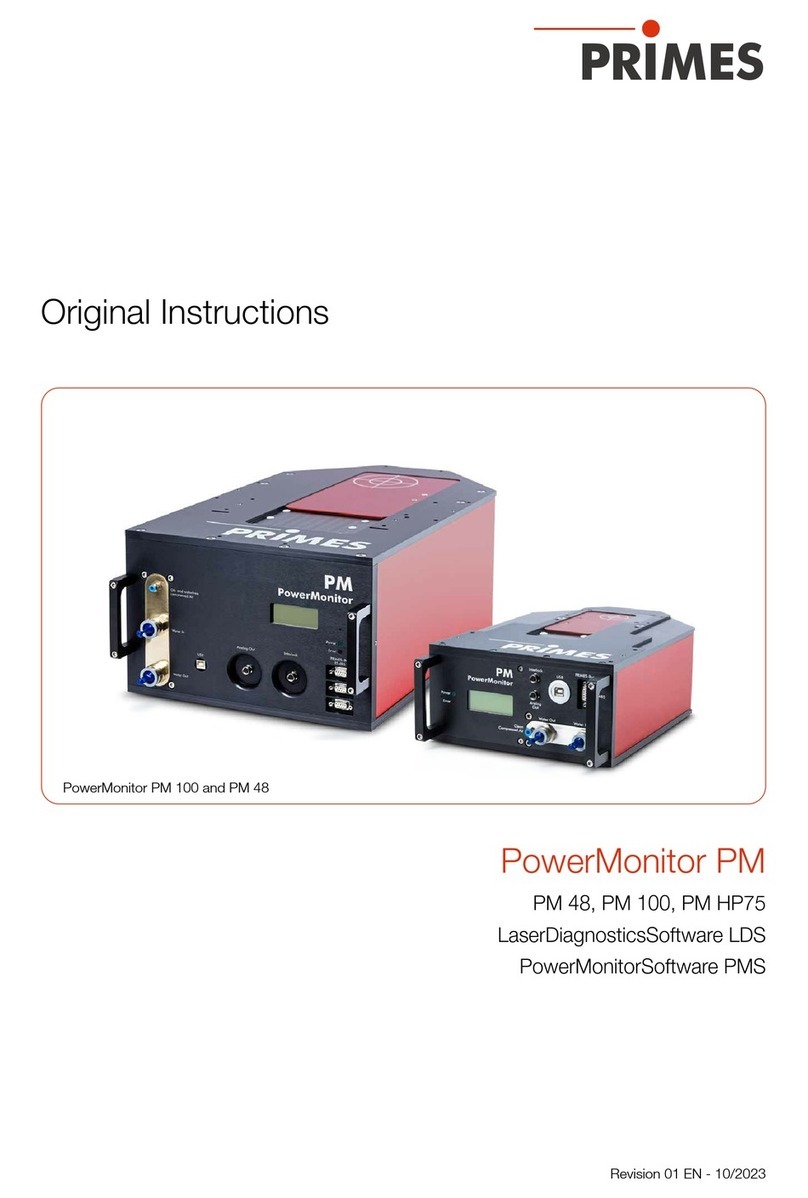
Primes
Primes PowerMonitor PM Series Original instructions

Riken Keiki
Riken Keiki RS-400 Series operating manual

ipf electronic
ipf electronic PT169070 instruction manual
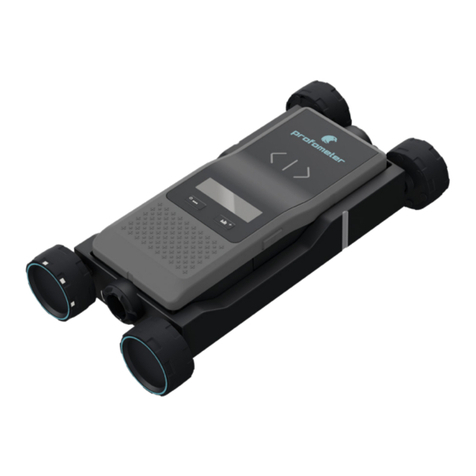
profometer
profometer PM8000 quick reference
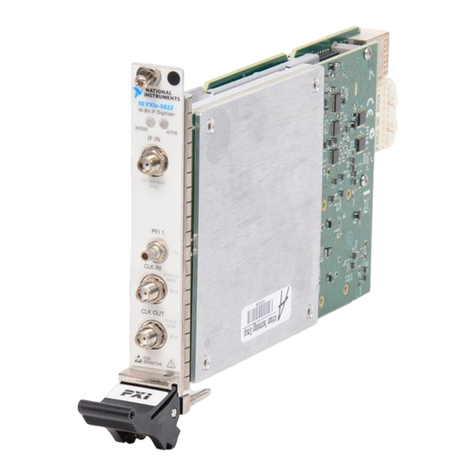
National Instruments
National Instruments NI PXI-562 Series user manual
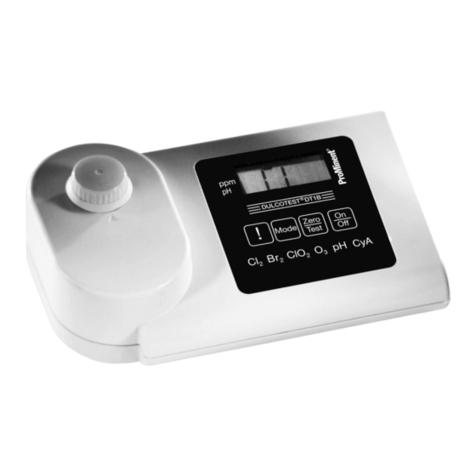
ProMinent
ProMinent DULCOTEST DT1B operating manual
